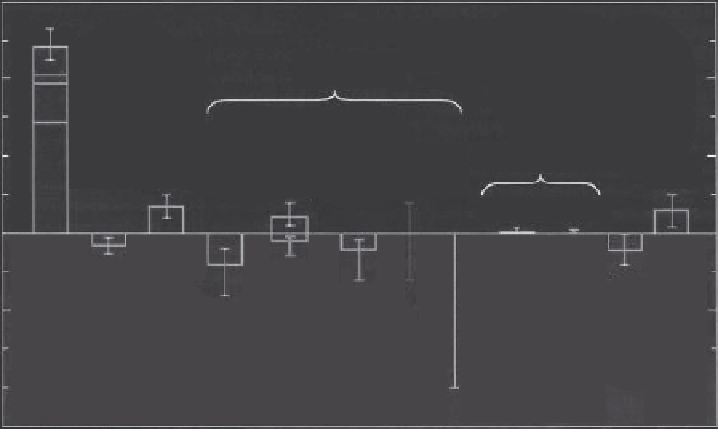Environmental Engineering Reference
In-Depth Information
3
Halocarbons
N
2
O
2
Aerosols
CH
4
Black
carbon from
fossil
fuel
burning
CO
2
1
Tropospheric
ozone
Mineral
dust
Aviation-induced
Solar
Contrail cirrus
0
Stratospheric
ozone
Organic
carbon
from
fossil
fuel
burning
Land-
use
(albedo)
only
Biomass
burning
Aerosol
indirect
effect
-1
Sulfate
-2
High Medium
Medium Low
Very
low
Very
low
Very
low
Very
low
Very
low
Very
low
Very
low
Very
low
Level of scientific understanding
FIGURE 13.2
Estimated radiative forcings since preindustrial times for the Earth and atmosphere's tro-
posphere system. (From National Academy of Sciences (NAS),
Radiative Forcing of Climate Change:
Expanding the Concept and Addressing Uncertainties
, National Research Council, Committee on Radiative
Forcing Effects on Climate, Climate Research Committee, Washington, DC, 2005.)
13.3.1 s
Hort
-t
erM
e
xPosure
e
FFects
oF
PM
Acute (short-term) exposure to particulate air pollution has been found to be associated with
increases in the rates of daily asthma attacks, hospital admissions, and mortality. PM is associated
with increased risk of respiratory hospital admissions in many cities including New York, NY;
Buffalo, NY; and Toronto, Ontario, as well as with mortality in numerous cities such as Chicago,
IL, and Los Angeles, CA (e.g., Thurston et al., 1992). These effects were also observed elsewhere
in the United States, and in other cities throughout the world, including national multicity studies
(Schwartz, 1997; Bell et al., 2004; Dominici et al., 2006; Samoli et al., 2008).
In addition to lung damage, recent epidemiological and toxicological studies of PM air pollution
have shown adverse effects on the heart, including an increased risk of heart attacks. For example,
when PM stresses the lung (e.g., by inducing edema), it places extra burden on the heart, which can
induce fatal complications for persons with cardiac problems. Indeed, Peters et al. (2001) found that
elevated concentrations of ine particles (PM ≤ 2.5 μm in aerodynamic diameter, i.e., PM
2.5
) in the air
could elevate the risk of myocardial infarctions (MIs) within a few hours, and extending 1 day after
PM
2.5
exposure. Others found that a 48% increase in the risk of MI was associated with an increase of
25 μg/m
3
PM
2.5
during a 2 h period before the onset of MI, and a 69% increase in risk to be related to an
increase of 20 μg/m
3
PM
2.5
in the 24 h average 1 day before the MI onset (Peters et al., 2001).
Epidemiologic research conducted in the United States and elsewhere has indicated that acute
exposure to PM air pollution is associated with increased risk of mortality. For example, a national
multicity time-series statistical analysis of mortality and PM ≤ 10 μm in aerodynamic diameter
(PM
10
) air pollution in 90 U.S. cities indicates that a 10 μg/m
3
increase in daily PM
10
is associated
with an increase of approximately 0.3% in the daily risk of death (Dominici et al., 2005). The
epidemiological results—in this case a 0.3% change in the daily mortality rate—are tied to the
increment of pollution, in this case a 10 μg/m
3
increase of PM
10
. In other words, the studies indicate

Search WWH ::

Custom Search